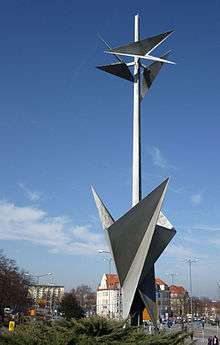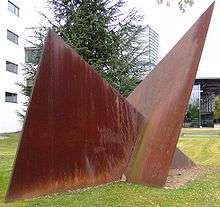Hermann Glöckner
Hermann Glöckner (21 January 1889 – 25 May 1987) was a German painter and sculptor. He was an important representative of constructivism.

Glöckner was born in Cotta near Dresden. He attended the vocational school in Leipzig in 1903 and worked as a designer for textiles. From 1904 to 1911 he attended the evening classes at the Kunstgewerbeschule in Dresden, where he became friends with Kurt Fiedler.[1] Among their lectures were Oskar Seyffert and Carl Rade, who later was a renowned professor at the Dresden Academy of Fine Arts and remained a friend of Glöckner for many years. Glöckner was mainly interested in drawings, but also in projections and geometry. From 1914 to 1918 he served in infantry divisions in France, Russia, and Poland.
After World War I Glöckner earned some money with the copying of paintings for the Gemäldegalerie Alte Meister. At the Dresden Academy of Fine Arts he studied with Otto Gussmann from 1923 to 1924.[2] Hans Grundig was among his fellow students. His experimental style, however, did not find everyone's appreciation and Glöckner left the academy again.[3] As a freelancer he turned to constructivism ever deeper during the following years. In 1932 he became a member of the re-founded Dresdner Sezession. The Nazis refused him any opportunities to exhibit and sell his paintings and graphics. So he turned to sgraffito to earn his living.
Glöckner lost his home during Bombing of Dresden in World War II and moved to Loschwitz. Because of his formalist style, the officials of the GDR refused him the appreciation he deserved for a long time. His rehabilitation began with an exhibition of his graphical work in the Kupferstichkabinett, Dresden in 1969. In 1979 he received a permanent visa for the Federal Republic of Germany. Finally, in 1984, he was awarded with the National Prize of the GDR and the DEFA dedicated a film to him. Centrally in the area of the Technische Universität Dresden he was allowed to erect a sculpture, which had been banned just a few years before. Another sculpture was erected one year later in the park of the Hotel Bellevue, Dresden's first address that time.
In his later years Glöckner regularly visited West Berlin, where his cohabitee lived and where he died in 1987.[4] Glöckner's urn was entombed in Loschwitz. A street in Loschwitz, newly built in 2008, is named after him.[5]
Works
Glöckner made his works from objects he had on hand: twine, cardboard, match boxes, and wood scrapes. These common objects were put together in a unique way to create something entirely new. This art was private with the only audience being his wife.[6]
See also
References
- Hermann Glöckner – Ein Patriarch der Moderne. Ed. by John Erpenbeck. Der Morgen. Berlin 1983
- Die großen Dresdner. 26 Annäherungen. Ed. by Karin Nitzschke. Insel Verlag. Frankfurt am Main und Leipzig 1999
- Günter Meissner: Allgemeines Künstlerlexikon: die bildenden Künstler aller Zeiten und Völker. K.G. Saur Verlag 1992. pp 198–201
- "Exhibition at the Institut für Auslandsbeziehungen (ifa)". Archived from the original on 16 November 2014. Retrieved 22 May 2013.
- "Hermann Glöckner in Dresden". Archived from the original on 27 May 2013. Retrieved 22 May 2013.
- "Archived copy". Archived from the original on 5 February 2015. Retrieved 5 February 2015.CS1 maint: archived copy as title (link)
External links
| Wikimedia Commons has media related to Hermann Glöckner. |
- Hermann Glöckner in the German National Library catalogue
- Bibliography at the Smithsonian Institution
- Works at Europeana
